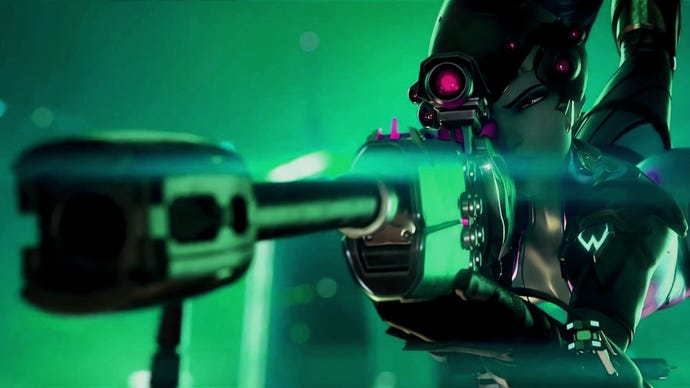I dismissed Nvidia Reflex as for esports superstars - but now I don’t want to go back to life without it
Nvidia's input lag reducing technology might seem like it's most suited for esports wannabes, but it's more useful than you'd think.
One of the best things about graphics card hardware from Nvidia is the software that accompanies it. In a tight, closely competitive competition between it and AMD, software has always been one of the key differentiators. In the last hardware generation, Nvidia added a new piece of software that I casually dismissed - but as the 3000 series generation drew to a close, I finally tried it - and found myself hooked on it.
I’m talking about Nvidia Reflex, a little bonus software option that uses your fancy high-end graphics hardware and various clever methods to reduce the input lag between your input devices - primarily keyboard and mouse, of course, but this’d also work with controllers - in turn theoretically making you more deadly in-game.
When the 30-series first launched, I dabbled with Reflex but never really paid it too much attention. I was more interested in improved versions of the frame-rate boosting DLSS, and how it’d let me crank up the visual fidelity and real-time lighting in newer games like Cyberpunk 2077. But recently, I returned to Reflex - and in that return, I realized what an impressive tool it is.
We talk a lot about frame rate and network latency in games, but we don’t nearly as often talk about system latency. I’ve always been aware of it - in my competitive RTS days, I refused to use a wireless mouse, superstitious that doing so invited more lag. I’ve read in-depth articles about which arcade sticks induce the fastest on-screen response time. But that was about the limit. You’d get the best peripherals available and that was it; there were no other steps to limit or offset it. Which is where Nvidia Reflex comes in.
Nvidia has a single app to thank for my conversion to a fan of the tool - a little Overwatch test map designed strictly to demonstrate what Reflex does for you in real time. Basically: you’re locked in place, with a sniper rifle, and another character repeatedly dashes through a distant doorway. You try to click the mouse to fire as they dash past - first with Reflex off, and then you turn it on. The difference is night-and-day. Some testing has even shown that Reflex is as good as using the in-game frame limiter - which means you can have that sweet, unlocked frame rate while keeping lag minimal.
I knew this was what Reflex did, of course, both from mild experimentation and from Nvidia’s 2021 marketing blitz. But it wasn’t until I sat down with Overwatchl that I realized just how useful the tool would be for even a mid-tier scrub like me. When I saw Nvidia’s marketing, I thought, you know - at my level of play, what difference would a couple of milliseconds make? I’m not in the Overwatch League. But then… I tried it.
And I guess you need to try it to believe it. I went from making like one headshot in twelve to doing nine or ten. It’s a big difference. The main thing I couldn’t believe is how big an improvement it made to me, with my average reactions and out-of-practice FPS skills.
The result is that if Reflex is available in a game, I’m turning it on. It’s in Overwatch 2, but is also available in a range of other games including Rainbow Six Siege & Extraction, Fortnite, Apex Legends, and a range of Call of Duty games. There’s even some less twitch-intensive campaign-focused games in the mix like Deathloop, and some non-shooters like God of War and iRacing. I can see a case for this lag reduction in a lot of games, in fact - I salivate at the idea this could come to Street Fighter 6 (Capcom, Nvidia - make it happen).
AMD has its own lag-reduction technology too, but in the testing and reading I’ve done, it doesn’t appear to be as impressive as Nvidia’s. But furthermore, one thing that keeps driving Nvidia forward is how their various technologies are meshing and interacting.
For Reflex, this is best demonstrated in Cyberpunk 2077, where on the new 4000-series GPUs, starting with the RTX 4090, you can run the game at well over 120fps on maxed-out settings thanks to DLSS 3, a new upgrade to that separate piece of technology. The catch? By generating extra frames, which is what DLSS 3 does, it induces extra lag. Nvidia’s solution is so simple as to be elegant - Cyberpunk 2077 compatibility with Reflex. DLSS 3 Raises your frame rate at the cost of extra latency - but then Reflex reduces latency, offsetting the ‘damage’ DLSS 3 does. The result is a game that feels the same or better, but with that sky-high frame rate and mega settings.
In this sense, one can see how a combination of DLSS 3 and Reflex can form something of a killer app for the GeForce RTX technology. You can see how it might be the future of maximizing settings and visuals without hurting the rest of your experience. But even without that, I’ve been thrilled and impressed with Reflex in shooters as a raw latency reduction tool. It’s not just for top-rank esports nerds! I only wish I’d started using it sooner.








.jpg?width=291&height=164&fit=crop&quality=80&format=jpg&auto=webp)


